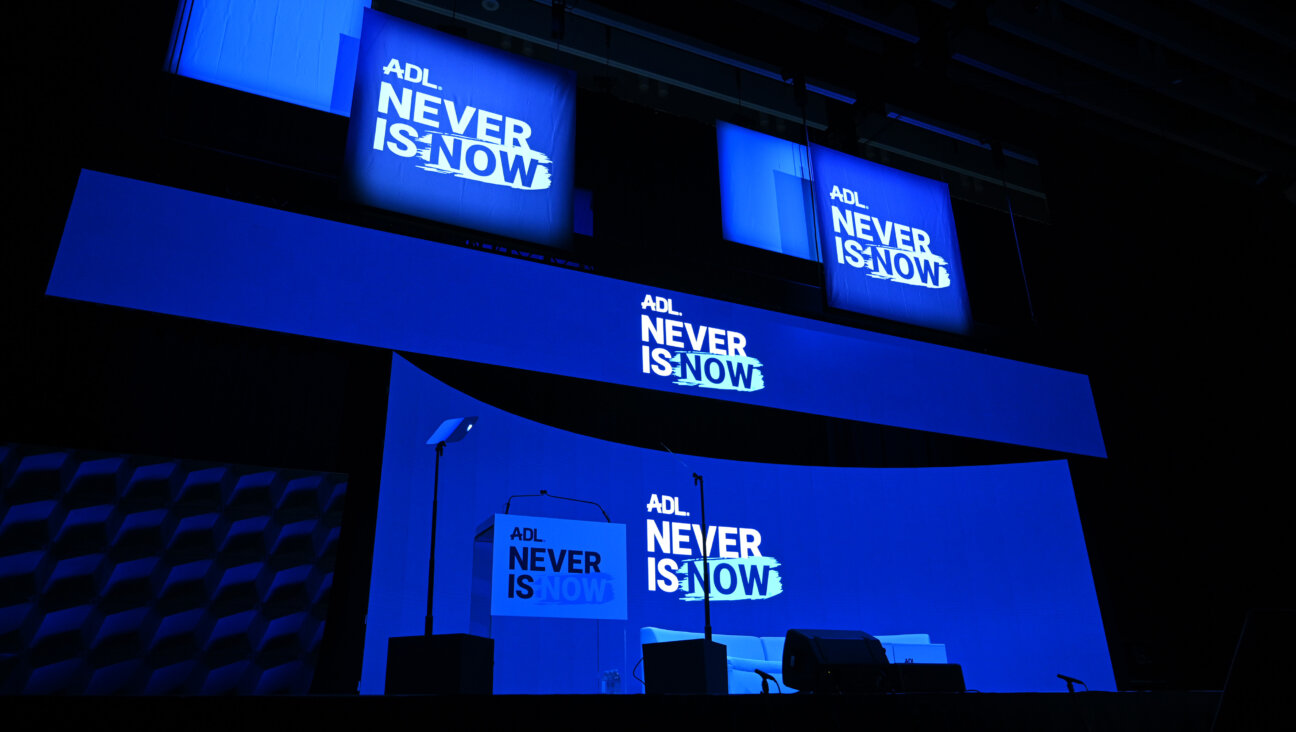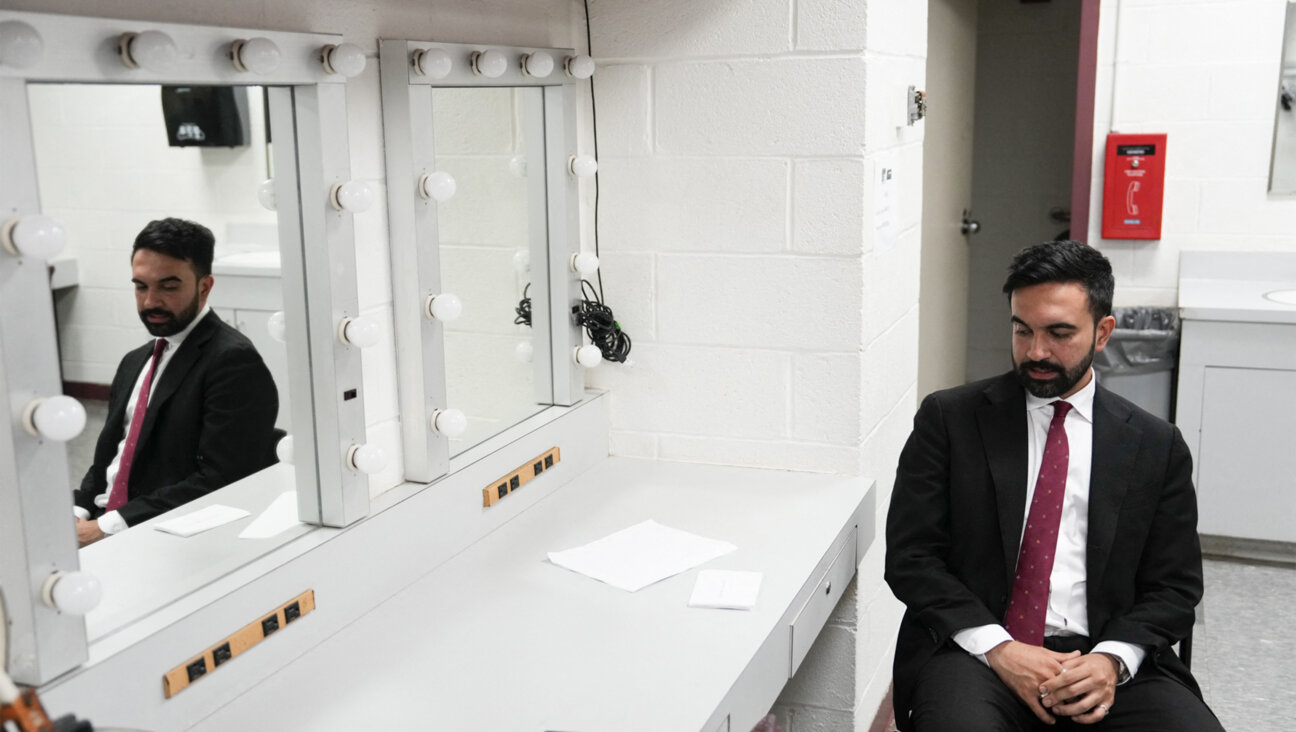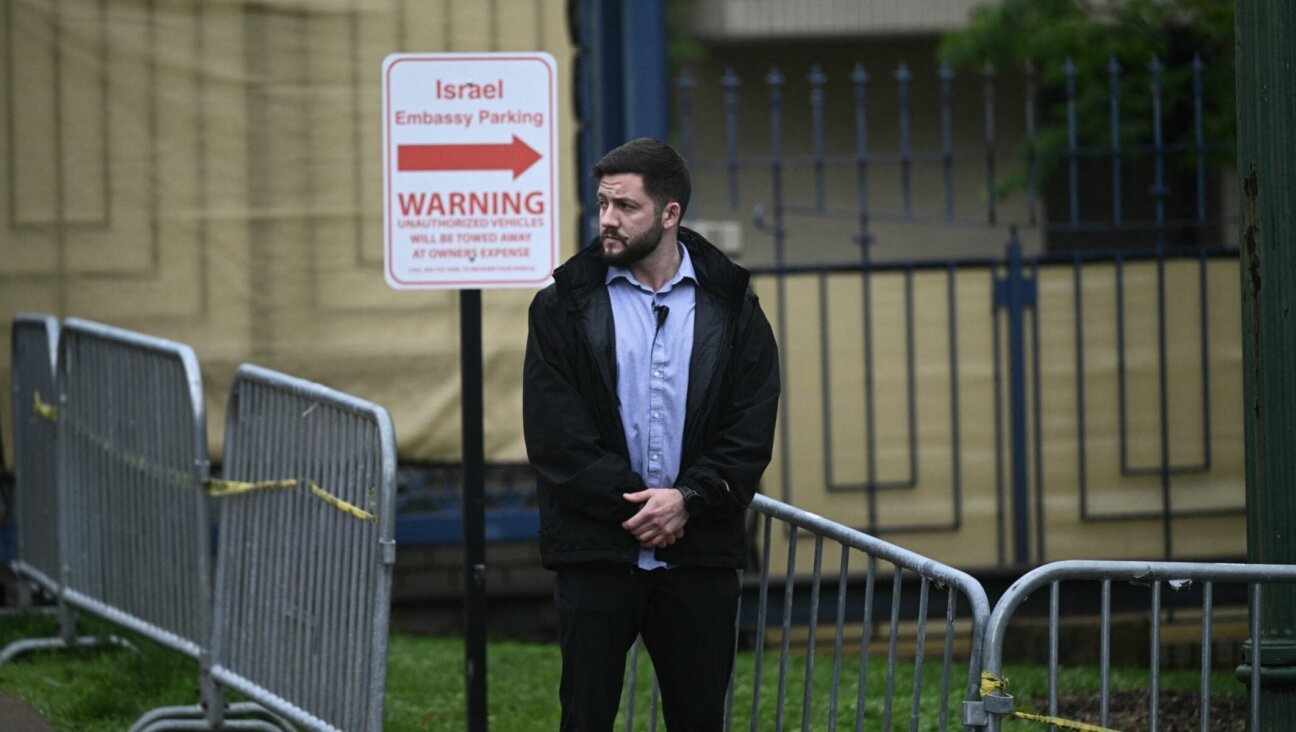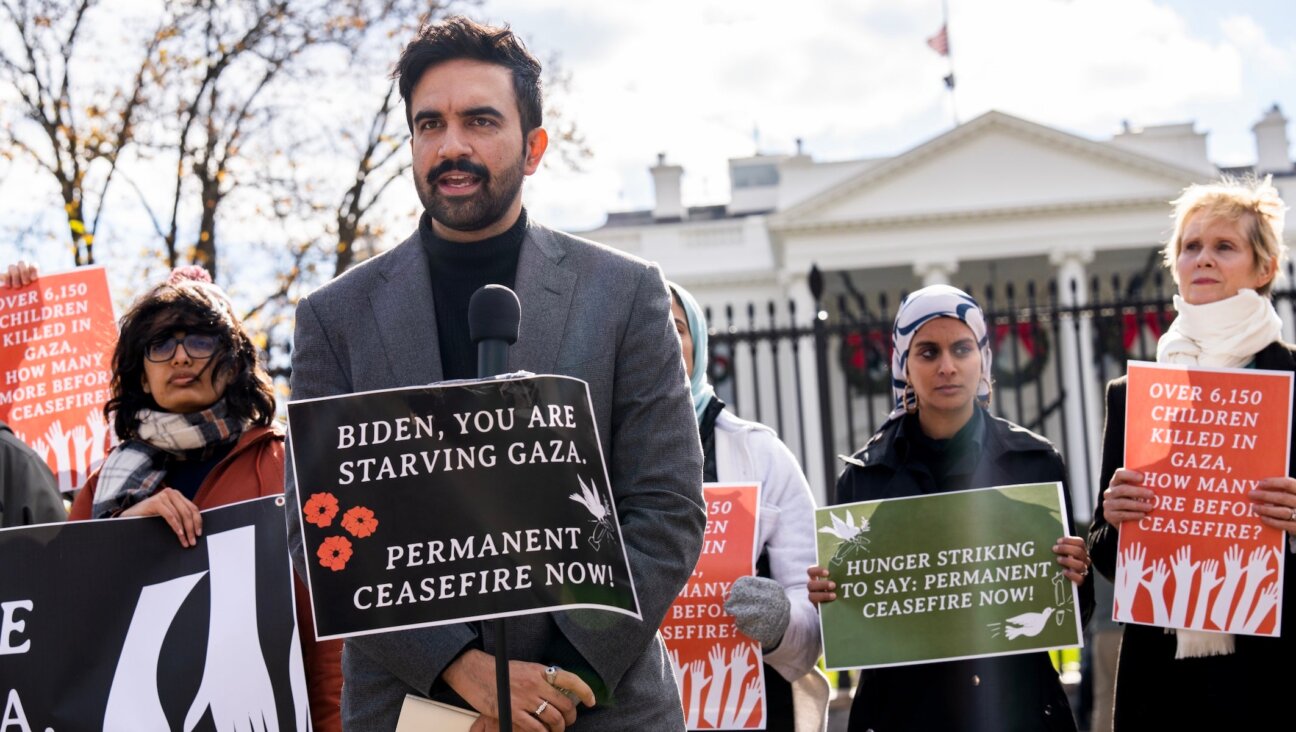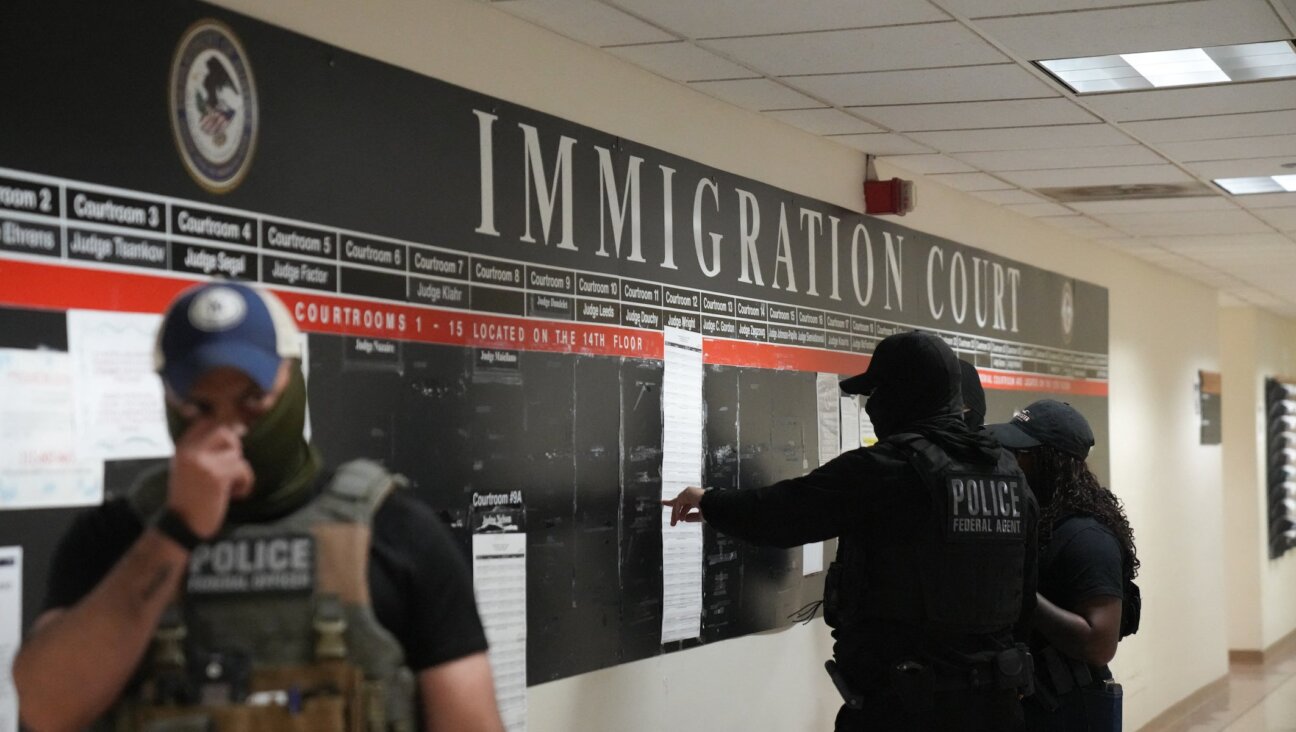Leo Frank Case Stirs Debate 100 Years After Jewish Lynch Victim’s Conviction

A century ago, Cobb County, Ga., was a sleepy farming community outside Atlanta, home to about 25,000 people. Now the county is an affluent suburb with a population of 700,000, including a booming Jewish community of about 8,000 families served by four synagogues, two restaurants doling out bagels and deli food, and a Kroger supermarket with a large kosher section.
“It’s changed so much by the influx of new people that it’s almost like a fairy tale that the lynching ever occurred,” said Roy Barnes, former governor of Georgia, as he sat in his wood-paneled office just off the main square in Marietta, the county’s largest city and its seat of government.
But the lynching did occur, just a couple of miles from Barnes’s law office, when an angry mob led by Marietta’s elite — including Barnes’s wife’s grandfather — stormed a remote prison, kidnapped Leo Max Frank, brought him back to Marietta and hung him from an oak tree in what is believed to be the only lynching of a Jew in America.

Image by Paul Berger
Frank’s lynching provided the denouement for one of the 20th century’s most contentious and consequential murder trials, galvanizing both the infancy of the Anti-Defamation League and the rebirth of the Ku Klux Klan. The gruesome image of Frank — dressed in only a nightshirt, his neck broken by the noose, his lifeless body dangling from a tree as townspeople rejoiced — has become an iconic illustration of Southern anti-Semitism and hatred, an ugly trope that today still echoes in dark corners of the Internet.
But the story began nearly two years earlier, on August 25, 1913, when Frank was convicted of murdering Mary Phagan, a 13-year-old white girl from Marietta who worked in the factory that Frank managed. Outside the courtroom, a crowd of 5,000 celebrated the verdict, while Northern Jews — including Abraham Cahan, editor of the Forverts — denounced the trial as a travesty of justice.
Today, the oak tree where Frank was hung is long gone. Strip malls, the I-75 overpass and a 56-foot-tall metal hen, an advertisement for a fast-food restaurant referred to locally as “The Big Chicken,” have replaced the surrounding woods.
The story of the Frank trial and lynching is buried deep beneath layers of trauma, embarrassment and shame. And 100 years after Frank’s conviction for the murder of Mary Phagan, the debate over his guilt or innocence continues.
•
‘The case [against Frank] is not as feeble as most people say it is,” said Steve Oney, a former staff writer at the Atlanta Journal Constitution whose 2003 book, “And The Dead Shall Rise,” on Phagan’s murder and Frank’s lynching, took 17 years to research and write.
“It was a tremendous event,” Oney said. “It’s deeply complicated with all kinds of class and race and religious undercurrents, and then there’s just the overriding question of what happened. Who killed Mary Phgan, and who lynched Leo Frank?”
“It’s a double murder mystery and a social history,” Oney added. “For some reason, these two cases were so charged with deeper implications that the entire country ultimately got caught up in it.”
Phagan took the trolley from her home near Marietta for the 20-mile ride to Atlanta on April 26, 1913, bound for the Confederate Memorial Day parade. On her way into town, she stopped by the National Pencil Factory, in Atlanta, to pick up her pay.
It was a Saturday, and Frank, the factory’s superintendent, was at work as usual. He paid Phagan the $1.20 she was owed and, according to his later testimony, she went on her way. No one recalled seeing her again that day. During the early hours of the following morning, the night watchman found her body in the factory basement.
The girl’s hair and face were covered in soot and cinders; her dress had been pulled up above her knees, and her $1.20 was missing. There was a large gash on the side of her head, and she had been strangled with a piece of cord. Two garbled notes found next to the body implicated a “long, tall, black Negro” in the murder.
Over the following weeks, the Atlanta police botched the collection of evidence and arrested several suspects, including the black night watchman and a black factory sweeper. Eventually they turned their attention to Frank, who was arrested April 29. As the drama unfolded, the city’s newspapers competed for scoop after scoop to bring the Atlanta public and, soon the rest of America, a string of often embellished and sensational stories.
There was plenty of copy to go around. The murder of Mary Phagan and the trial of Leo Frank contained all the ingredients of a blockbuster story.
Phagan, the young, pretty child of a typical lower-class Georgia family, represented all that was innocent and pure among the exploited and downtrodden families of the South. Fifty years after the Civil War —known to Georgians as the War of Northern Aggression — many families were still scrambling to get by. The pencil factory, like many Atlanta mills and factories of the day, profited off child labor.
Frank, 29, represented much of what locals despised about the North. Awkward and effete, he was born in Texas and raised in New York. Frank had a degree from Cornell University. He moved to Atlanta in 1908 to work at the pencil factory, which was part owned by his uncle, Moses Frank. In 1910 he married Lucille Selig, daughter of a prominent German-Jewish family, and together they enjoyed the fruits of Atlanta’s privileged world.
During the trial of August 1913, the star witness against Frank was the black factory sweeper, James Conley, who had initially denied to police that he knew anything about the murder. Following weeks of imprisonment and interrogation, and after changing his affidavit four times, Conley told police that Frank had murdered the girl after she resisted his advances and that Frank had asked Conley to help him move her body. Conley testified that Frank dictated the murder notes to him to throw police off Frank’s trail.
Conley gave convincing testimony and withstood three days of cross-examination. A reader of the Forverts, on August 26, could have been forgiven for suspecting that Frank was guilty. “Several witnesses testified that Frank had a corrupt and immoral character and that he consistently harassed the women and girls who worked in the factory, and these stories very much stirred public opinion against him,” the Forverts reported.
But the Forverts added that there was also a suspicion of anti-Semitism. “Many, however, say that such hatred is prevalent towards Frank because he is a Jew and he is successful,” the paper reported. “His lawyers discussed this openly in court in their defense of Frank.”
The judge was so nervous for the defendant’s safety that he asked for Frank to be kept away from the courtroom for the verdict that day. When the guilty verdict was announced, thousands who had gathered in the streets outside the courthouse cheered.
•
Fresh flowers, small toys and tchotchkes still adorn the grave of “Little Mary Phagan” in Marietta City Cemetery. Such is the evidence that people still make a pilgrimage up the hillside to where she is buried, surrounded by the tombstones of relatives and some of the old Marietta families that formed Frank’s lynch party.
Even today, new memorials are still being planned. On June 1, The Marietta Daily Journal ran a small news item reporting that Commander Jack Bridwell, of the Georgia Division of the Sons of Confederate Soldiers, announced that that day and every subsequent June 1 would be marked as “Little Mary Phagan Day.”
“They asked for my approval on that,” Mary Phagan-Kean, the victim’s 59-year-old great-niece told the Forward. Kean, who moved to Ellijay, 80 miles north of Marietta, last year, assented to Bridwell’s request with the caveat that Mary Phagan’s name could never be used for “prejudicial purposes.”
“You wouldn’t believe the calls I get from crazy people,” Kean said.
The Frank case has long been a magnet for anti-Semitic groups. A few decades ago, the Ku Klux Klan marched through Marietta to Phagan’s grave to protest a movement to secure a posthumous pardon for Frank.
Anti-Semitic attitudes certainly played a role in Frank’s lynching. But Kean’s family, which is firmly convinced of Frank’s guilt, denies that anti-Semitism explains his conviction.
In this respect, Kean has some support from Frank himself. Cahan traveled to Atlanta in March 1914 to visit Frank in his cell. In the fifth volume of Cahan’s memoirs, published in Yiddish in 1931, Cahan relates that Frank told him the Atlanta police were desperate for a conviction. Mary Phagan’s murder presented a huge challenge for prosecutor Hugh Dorsey, who had just come off the back of two embarrassing courtroom defeats.
“Anti-Semitism is absolutely not the reason for this libel that has been framed against me,” Frank told Cahan. “It isn’t the source nor the result of this sad story.”
Instead, Frank said, police had “taken advantage” of Frank’s Jewishness to undermine his case. They had disparaged Jews in general so “that a Negro against a Jew is believable.“
Indeed, Frank’s lynching stands out — as a white man, his lynching was the exception rather than the norm. Almost a decade earlier, 25 black people were killed and 150 injured during a 1906 race riot in Atlanta that was sparked by reports of a white woman being raped by a black man. In 1915, the year of Frank’s lynching, 21 black people were lynched, including one, John Riggins, who was hanged in South Georgia the same day as Frank.
By contrast, Jews were well integrated into Southern society. Many prominent Atlanta businessmen — the Riches, the Elsases, the Hirsches and the Seligs — were Jewish. Even in Marietta, the small Jewish community owned businesses and prospered. But Frank’s trial, conviction and appeal brought out an ugly side in the community, a side that was inflamed by the press.
Adolph Ochs, publisher of The New York Times, was the most prominent of a number of Northern newspaper owners to wage a campaign casting aspersions on the trial. The perception of Northerners interfering in Southern justice was grist for anti-Semites such as Thomas Watson, a former congressman and vice presidential candidate whose newspaper, the Jeffersonian, railed against “the Northern papers, which are owned by rich Jews.”
“This campaign of lies, abuse, defamation and race hatred gets worse and worse,” Watson wrote in a typical editorial in early 1915. “It must be costing the Chosen People a lot of money.”
While Frank was being retried in the court of public opinion, his lawyers fought to win an appeal. They argued that the hostile public sentiment that had precluded Frank from the courtroom proved he hadnot received a fair trial.
Even Conley’s lawyer, William Smith, joined Frank’s defense. When an analysis of the two notes found at the murder scene appeared to show that Frank could not have dictated them, Smith became convinced the murder could only have been the work of Conley.
Frank’s lawyers appealed all the way to the U.S. Supreme Court, where the justices found 7–2 against Frank. His lawyers pressed on. In June 1915, they persuaded Georgia Governor John Slaton, then in his last days in office, to commute Frank’s sentence to life in prison.
Overnight, Frank was moved about 100 miles southeast to a prison at Milledgeville. The reaction was swift. A mob of thousands marched on the governor’s mansion. In Marietta, Slaton was hanged in effigy. An inmate at Milledgeville took matters into his own hands and slit Frank’s throat. But he survived.
Most Jews who know about Leo Frank believe that he was innocent. “He was wrongly accused, unjustly tried and wantonly murdered,” said Rabbi Steve Lebow of Temple Kol Emeth, in Marietta.
Lebow has waged a decades-long campaign to raise Frank’s profile and to secure a pardon. He was instrumental in erecting two plaques on the side of an office building closest to the believed site of Frank’s lynching within sight of The Big Chicken. The majority of Atlanta’s Jews have, at best, a vague knowledge of Frank’s case, if they have heard of it at all.
The last major attempt to pardon Frank, during the 1980s, was bolstered by the testimony of Alonzo Mann, a former pencil factory worker who said he had seen Conley struggling to carry Phagan’s body, alone. Mann, who was a teenager at the time of the murder, said his mother had told him to keep quiet.
The appeal was only a partial success. In 1986, the Georgia Board of Pardons and Paroles found that there was insufficient evidence to clear Frank of Phagan’s murder. Instead, the parole board pardoned Frank on the grounds that the state failed to protect him and to provide an “opportunity for continued legal appeal of his conviction.”
Frank was abducted from the Milledgeville prison the night of August 16, 1915. The scar on his neck, from the attempt on his life less than a month earlier, had barely healed. A group of armed men, thought to number about 25, had driven south from Marietta through back roads earlier that evening, in seven cars. They cut the phone lines to the prison, overpowered prison staff and whisked away Frank, still dressed in his nightshirt.
“It was a feat of some daring,” said Oney, who linked some of Marietta’s elite to the crime by researching the area’s car owners in 1915. “All told, it was a 300 miles round trip, in the dead of night, on largely unpaved roads, in Model Ts and other cars of that vintage, with flat tires and magnesium headlights you had to light with a spark device.”
The convoy arrived at a wooded grove known as Freys Gin, a couple of miles outside Marietta, in the early morning of August 17. Frank was blindfolded, his arms handcuffed and legs bound. He was hoisted onto a table, where a noose was placed around his neck. Then the table was kicked away.
Over the course of the morning, a crowd of gawkers grew around the lynch site. “The crowd was an unruly, fanatically wild mass,” the Forverts reported. “With each passing moment it became even more infused with race hatred, with a lust to kill.” When the body was cut down, a member of the crowd stomped on Frank’s face.
The doctor who examined Frank’s body later told the Forverts: “There were well-defined markings of a sole of a shoe on his nose and near his left eye. His left ear was practically torn off. Many wounds to the skull. His facial expression was one of terror through having been brutalized.”
Marilyn Hurwitz, whose grandparents owned a store in Marietta at the time, said the mood in the town was grim. Her mother recalled how a mob gathered outside the family store the night after the lynching. Hurwitz, now 82, said the family had to rush through the crowd to make it to a streetcar bound for Atlanta. Her grandfather opened his store the following day, but he did not sleep in Marietta for some time afterward, Hurwitz said.
The lynching affected the Jews of Atlanta, too. Tony Montag, whose family owned a controlling stake in the National Pencil Company, said. “My father told me it was the first time he’d ever seen his father with a gun.”
Atlanta’s German-Jewish elite now had to live in a community that included people who supported Frank’s conviction and the lynching. They coped by not talking about Frank. Montag said of his father: “If people did start talking about it in a social context, he would get up and leave the room. It was just a painful memory to him.”
The events of 1913 to 1915 threw two contradictory forces into motion in Atlanta. Frank was president of a local lodge of B’nai B’rith, the Jewish fraternal organization. His lynching galvanized the newly formed Anti-Defamation League, which went on to become the pre-eminent American Jewish organization to fight bigotry and intolerance.
A few months after Frank’s lynching, atop Stone Mountain, about 35 miles from Marietta, the reconstituted Ku Klux Klan held its first cross burning. The Klan was spurred partly by the release in 1915 of the movie “The Birth of a Nation.” But it was also bolstered by the nativist writings in Watson’s Jeffersonian and by the rising xenophobia in Atlanta over the previous two years.
•
Though the lynching frightened Atlanta’s Jewish community, most Jews remained in and around the city. As Atlanta’s population has grown rapidly in recent decades, the Jewish community has grown even faster.
Until recently, Cobb County had one of the fastest-growing Jewish communities in metropolitan Atlanta, which itself was among the fastest-growing communities in America. During the last population survey, in 2006, conducted by the Jewish Federation of Greater Atlanta, the community had grown 56% in the previous decade, to 120,000 Jews.
A century after Frank’s conviction, there appears to be little appetite in the community — apart from Lebow — to push for exoneration. Oney said that his 17 years of research led him to believe that Conley probably murdered Phagan, but there is enough doubt to “leave the door ajar.” So much evidence has been bungled, destroyed or lost since the murder that to be able to say with 100% certainty that Frank is innocent “would give me a power of clairvoyance that I don’t have,” Oney added.
Today, the trial and the lynching seem unimaginable in Atlanta. But they were unimaginable a century ago, too.
When Cahan visited Frank in 1914, he told Frank that he wanted to send a telegram to New York explaining to readers what it is like to be an innocent man sentenced to death. Cahan said that Frank smiled and took from his pocket a pencil and a piece of card.
“The whole story seems like a dream to me,” Frank wrote. “It seems to me that I’m observing it from the side; it belongs to somebody else, not me. For the moment, I feel no fear at all.”
Contact Paul Berger at [email protected] or on Twitter, @pdberger










